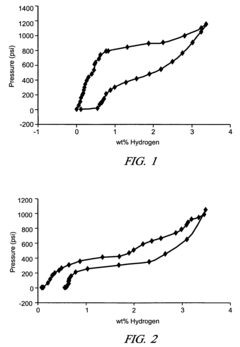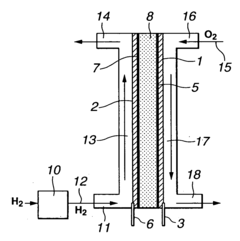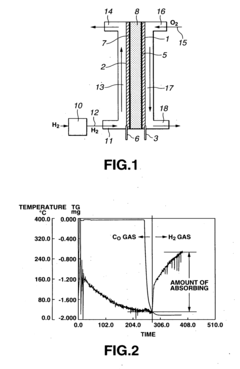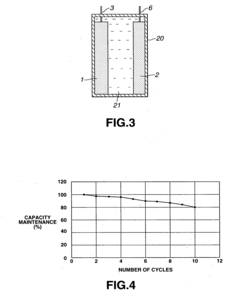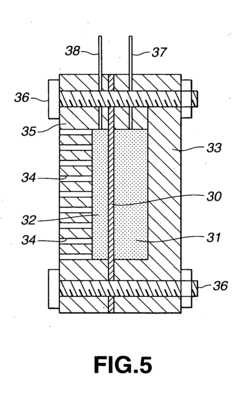Polycarbonate for Hydrogen Fuel Storage Systems
JUL 1, 20259 MIN READ
Generate Your Research Report Instantly with AI Agent
Patsnap Eureka helps you evaluate technical feasibility & market potential.
Hydrogen Storage Tech Evolution and Objectives
Hydrogen storage technology has undergone significant evolution since its inception, driven by the growing demand for clean energy solutions and the need to reduce greenhouse gas emissions. The development of hydrogen storage systems has been a critical factor in advancing the hydrogen economy, particularly in the transportation sector.
In the early stages, hydrogen storage primarily relied on compressed gas cylinders, which were bulky and limited in capacity. As research progressed, cryogenic liquid hydrogen storage emerged as a more efficient alternative, offering higher energy density. However, this method faced challenges related to insulation and boil-off losses.
The focus then shifted towards solid-state storage methods, including metal hydrides and chemical hydrides. These materials offered improved safety and volumetric efficiency but struggled with weight and thermal management issues. Concurrently, adsorption-based storage using porous materials like activated carbon and metal-organic frameworks gained attention for their potential in low-pressure storage applications.
Recent years have seen a renewed interest in advanced composite materials for hydrogen storage, with polycarbonate emerging as a promising candidate. Polycarbonate offers a unique combination of properties, including high impact strength, thermal stability, and excellent barrier characteristics, making it an attractive option for hydrogen fuel storage systems.
The primary objectives of current research on polycarbonate for hydrogen storage are multifaceted. Firstly, there is a focus on enhancing the material's hydrogen permeation resistance to minimize leakage and improve overall system efficiency. Secondly, researchers aim to optimize the mechanical properties of polycarbonate to withstand high-pressure conditions while maintaining structural integrity over extended periods.
Another crucial objective is to develop polycarbonate-based composite materials that can operate effectively across a wide temperature range, addressing the challenges associated with hydrogen embrittlement and thermal cycling. Additionally, there is a strong emphasis on improving the manufacturing processes to enable the production of complex geometries and large-scale components necessary for practical hydrogen storage applications.
The long-term goal of this research is to create lightweight, durable, and cost-effective hydrogen storage solutions that can meet the demanding requirements of various applications, from automotive fuel cells to stationary power systems. By advancing polycarbonate technology for hydrogen storage, researchers aim to overcome existing barriers to widespread hydrogen adoption and contribute to the transition towards a sustainable energy future.
In the early stages, hydrogen storage primarily relied on compressed gas cylinders, which were bulky and limited in capacity. As research progressed, cryogenic liquid hydrogen storage emerged as a more efficient alternative, offering higher energy density. However, this method faced challenges related to insulation and boil-off losses.
The focus then shifted towards solid-state storage methods, including metal hydrides and chemical hydrides. These materials offered improved safety and volumetric efficiency but struggled with weight and thermal management issues. Concurrently, adsorption-based storage using porous materials like activated carbon and metal-organic frameworks gained attention for their potential in low-pressure storage applications.
Recent years have seen a renewed interest in advanced composite materials for hydrogen storage, with polycarbonate emerging as a promising candidate. Polycarbonate offers a unique combination of properties, including high impact strength, thermal stability, and excellent barrier characteristics, making it an attractive option for hydrogen fuel storage systems.
The primary objectives of current research on polycarbonate for hydrogen storage are multifaceted. Firstly, there is a focus on enhancing the material's hydrogen permeation resistance to minimize leakage and improve overall system efficiency. Secondly, researchers aim to optimize the mechanical properties of polycarbonate to withstand high-pressure conditions while maintaining structural integrity over extended periods.
Another crucial objective is to develop polycarbonate-based composite materials that can operate effectively across a wide temperature range, addressing the challenges associated with hydrogen embrittlement and thermal cycling. Additionally, there is a strong emphasis on improving the manufacturing processes to enable the production of complex geometries and large-scale components necessary for practical hydrogen storage applications.
The long-term goal of this research is to create lightweight, durable, and cost-effective hydrogen storage solutions that can meet the demanding requirements of various applications, from automotive fuel cells to stationary power systems. By advancing polycarbonate technology for hydrogen storage, researchers aim to overcome existing barriers to widespread hydrogen adoption and contribute to the transition towards a sustainable energy future.
Market Analysis for H2 Fuel Storage Solutions
The hydrogen fuel storage market is experiencing significant growth, driven by the increasing adoption of hydrogen as a clean energy source. The global market for hydrogen fuel storage solutions is projected to expand rapidly in the coming years, with a compound annual growth rate (CAGR) exceeding 10% through 2030. This growth is primarily fueled by the automotive sector, where hydrogen fuel cell vehicles are gaining traction as a viable alternative to battery electric vehicles for long-range and heavy-duty applications.
The demand for efficient and safe hydrogen storage systems is particularly strong in regions with well-developed hydrogen infrastructure, such as Japan, South Korea, Germany, and California. These markets are leading the way in hydrogen fuel cell vehicle adoption and are investing heavily in hydrogen refueling stations. As a result, there is a growing need for advanced storage solutions that can withstand high pressures and ensure the safety of hydrogen fuel.
Polycarbonate, known for its high impact resistance and thermal stability, is emerging as a promising material for hydrogen fuel storage systems. The market for polycarbonate-based storage solutions is still in its early stages but is expected to grow significantly as research and development efforts intensify. The automotive industry is showing particular interest in polycarbonate composites that can potentially reduce the weight and cost of hydrogen storage tanks while maintaining or improving safety standards.
Key market drivers for polycarbonate-based hydrogen storage solutions include the push for lightweight materials to improve vehicle efficiency, the need for cost-effective storage options to make hydrogen fuel cell vehicles more competitive, and stringent safety regulations that demand high-performance materials. Additionally, the growing focus on sustainable and recyclable materials in the automotive industry aligns well with polycarbonate's recyclability, further boosting its market potential.
However, the market faces several challenges. The high cost of polycarbonate compared to traditional materials like steel and aluminum is a significant barrier to widespread adoption. There are also technical hurdles to overcome, such as improving the gas barrier properties of polycarbonate to prevent hydrogen permeation and ensuring long-term durability under high-pressure conditions.
Despite these challenges, the market outlook for polycarbonate in hydrogen fuel storage systems remains positive. As research progresses and manufacturing techniques improve, the cost-performance ratio of polycarbonate-based solutions is expected to become more favorable. This, coupled with the material's potential to address key industry needs, positions polycarbonate as a strong contender in the evolving hydrogen storage market.
The demand for efficient and safe hydrogen storage systems is particularly strong in regions with well-developed hydrogen infrastructure, such as Japan, South Korea, Germany, and California. These markets are leading the way in hydrogen fuel cell vehicle adoption and are investing heavily in hydrogen refueling stations. As a result, there is a growing need for advanced storage solutions that can withstand high pressures and ensure the safety of hydrogen fuel.
Polycarbonate, known for its high impact resistance and thermal stability, is emerging as a promising material for hydrogen fuel storage systems. The market for polycarbonate-based storage solutions is still in its early stages but is expected to grow significantly as research and development efforts intensify. The automotive industry is showing particular interest in polycarbonate composites that can potentially reduce the weight and cost of hydrogen storage tanks while maintaining or improving safety standards.
Key market drivers for polycarbonate-based hydrogen storage solutions include the push for lightweight materials to improve vehicle efficiency, the need for cost-effective storage options to make hydrogen fuel cell vehicles more competitive, and stringent safety regulations that demand high-performance materials. Additionally, the growing focus on sustainable and recyclable materials in the automotive industry aligns well with polycarbonate's recyclability, further boosting its market potential.
However, the market faces several challenges. The high cost of polycarbonate compared to traditional materials like steel and aluminum is a significant barrier to widespread adoption. There are also technical hurdles to overcome, such as improving the gas barrier properties of polycarbonate to prevent hydrogen permeation and ensuring long-term durability under high-pressure conditions.
Despite these challenges, the market outlook for polycarbonate in hydrogen fuel storage systems remains positive. As research progresses and manufacturing techniques improve, the cost-performance ratio of polycarbonate-based solutions is expected to become more favorable. This, coupled with the material's potential to address key industry needs, positions polycarbonate as a strong contender in the evolving hydrogen storage market.
Polycarbonate H2 Storage: Current State and Challenges
The current state of polycarbonate for hydrogen fuel storage systems presents both promising advancements and significant challenges. Polycarbonate, a thermoplastic polymer known for its durability and optical clarity, has emerged as a potential material for hydrogen storage due to its unique properties and versatility.
In recent years, researchers have made substantial progress in developing polycarbonate-based composites that exhibit enhanced hydrogen storage capabilities. These composites often incorporate nanomaterials or other additives to improve the hydrogen absorption and desorption characteristics of the polymer matrix. Some studies have reported promising results, with certain polycarbonate composites demonstrating hydrogen storage capacities approaching those of traditional metal hydrides.
One of the key advantages of polycarbonate in hydrogen storage applications is its relatively low cost and ease of processing compared to some alternative materials. Additionally, polycarbonate's lightweight nature makes it an attractive option for mobile hydrogen storage systems, particularly in the automotive sector where weight reduction is crucial for improving fuel efficiency.
However, several challenges remain in the development of polycarbonate-based hydrogen storage systems. The primary obstacle is achieving sufficiently high hydrogen storage capacity while maintaining the structural integrity and safety of the storage vessel. Polycarbonate, in its pure form, has limited hydrogen permeability and storage capacity, necessitating significant modifications to enhance its performance.
Another challenge lies in the long-term stability of polycarbonate under hydrogen storage conditions. Exposure to high-pressure hydrogen over extended periods can lead to material degradation, potentially compromising the safety and reliability of the storage system. Researchers are actively working on developing more resistant polycarbonate formulations and protective coatings to address this issue.
The operating temperature range of polycarbonate-based hydrogen storage systems also presents a challenge. While polycarbonate performs well at ambient temperatures, its properties can change significantly at the extreme temperatures often encountered in hydrogen storage applications. This limitation requires careful engineering and material selection to ensure consistent performance across a wide temperature range.
Furthermore, the integration of polycarbonate-based hydrogen storage systems into existing infrastructure poses technical and logistical challenges. Compatibility with current fueling systems, safety regulations, and manufacturing processes must be carefully considered and addressed to enable widespread adoption of this technology.
Despite these challenges, ongoing research and development efforts continue to push the boundaries of polycarbonate's potential in hydrogen storage applications. Collaborative efforts between material scientists, engineers, and industry partners are driving innovation in this field, with a focus on overcoming current limitations and unlocking the full potential of polycarbonate-based hydrogen storage solutions.
In recent years, researchers have made substantial progress in developing polycarbonate-based composites that exhibit enhanced hydrogen storage capabilities. These composites often incorporate nanomaterials or other additives to improve the hydrogen absorption and desorption characteristics of the polymer matrix. Some studies have reported promising results, with certain polycarbonate composites demonstrating hydrogen storage capacities approaching those of traditional metal hydrides.
One of the key advantages of polycarbonate in hydrogen storage applications is its relatively low cost and ease of processing compared to some alternative materials. Additionally, polycarbonate's lightweight nature makes it an attractive option for mobile hydrogen storage systems, particularly in the automotive sector where weight reduction is crucial for improving fuel efficiency.
However, several challenges remain in the development of polycarbonate-based hydrogen storage systems. The primary obstacle is achieving sufficiently high hydrogen storage capacity while maintaining the structural integrity and safety of the storage vessel. Polycarbonate, in its pure form, has limited hydrogen permeability and storage capacity, necessitating significant modifications to enhance its performance.
Another challenge lies in the long-term stability of polycarbonate under hydrogen storage conditions. Exposure to high-pressure hydrogen over extended periods can lead to material degradation, potentially compromising the safety and reliability of the storage system. Researchers are actively working on developing more resistant polycarbonate formulations and protective coatings to address this issue.
The operating temperature range of polycarbonate-based hydrogen storage systems also presents a challenge. While polycarbonate performs well at ambient temperatures, its properties can change significantly at the extreme temperatures often encountered in hydrogen storage applications. This limitation requires careful engineering and material selection to ensure consistent performance across a wide temperature range.
Furthermore, the integration of polycarbonate-based hydrogen storage systems into existing infrastructure poses technical and logistical challenges. Compatibility with current fueling systems, safety regulations, and manufacturing processes must be carefully considered and addressed to enable widespread adoption of this technology.
Despite these challenges, ongoing research and development efforts continue to push the boundaries of polycarbonate's potential in hydrogen storage applications. Collaborative efforts between material scientists, engineers, and industry partners are driving innovation in this field, with a focus on overcoming current limitations and unlocking the full potential of polycarbonate-based hydrogen storage solutions.
Existing Polycarbonate H2 Storage Solutions
01 Synthesis and modification of polycarbonates
Various methods for synthesizing and modifying polycarbonates are explored, including novel catalysts, reaction conditions, and additives to improve properties such as molecular weight, thermal stability, and optical clarity. These techniques aim to enhance the overall performance and versatility of polycarbonate materials for different applications.- Synthesis and modification of polycarbonates: Various methods for synthesizing and modifying polycarbonates are explored, including new catalysts, reaction conditions, and additives to improve properties such as molecular weight, thermal stability, and optical clarity. These techniques aim to enhance the overall performance and versatility of polycarbonate materials.
- Polycarbonate blends and composites: Development of polycarbonate blends and composites with other polymers or materials to achieve improved mechanical, thermal, or electrical properties. These combinations can result in materials with enhanced impact resistance, flame retardancy, or conductivity, expanding the application range of polycarbonates.
- Polycarbonate processing and manufacturing: Advancements in processing techniques and manufacturing methods for polycarbonates, including extrusion, injection molding, and film formation. These innovations focus on improving production efficiency, reducing defects, and enhancing the quality of final polycarbonate products.
- Polycarbonate applications in electronics: Utilization of polycarbonates in electronic devices and components, such as display panels, circuit boards, and protective casings. The focus is on developing polycarbonate formulations with specific properties suited for electronic applications, including heat resistance, dimensional stability, and electrical insulation.
- Recycling and sustainability of polycarbonates: Methods for recycling polycarbonate materials and developing more sustainable production processes. This includes chemical recycling techniques, bio-based polycarbonate alternatives, and strategies to reduce the environmental impact of polycarbonate manufacturing and disposal.
02 Polycarbonate blends and composites
Development of polycarbonate blends and composites with other polymers or additives to achieve specific properties such as improved impact resistance, flame retardancy, or weatherability. These formulations expand the range of applications for polycarbonate-based materials in various industries.Expand Specific Solutions03 Polycarbonate processing techniques
Advancements in processing techniques for polycarbonates, including extrusion, injection molding, and film formation. These methods focus on optimizing production efficiency, reducing defects, and enhancing the final product quality for applications in electronics, automotive, and consumer goods industries.Expand Specific Solutions04 Polycarbonate surface treatments and coatings
Development of surface treatments and coatings for polycarbonate materials to improve properties such as scratch resistance, UV stability, and anti-fogging characteristics. These innovations enhance the durability and performance of polycarbonate products in various environmental conditions.Expand Specific Solutions05 Recycling and sustainability of polycarbonates
Advancements in recycling technologies and sustainable production methods for polycarbonates, including chemical recycling, bio-based alternatives, and energy-efficient manufacturing processes. These innovations aim to reduce the environmental impact of polycarbonate production and improve the material's overall lifecycle sustainability.Expand Specific Solutions
Key Players in Polycarbonate H2 Storage Industry
The research on polycarbonate for hydrogen fuel storage systems is in an early development stage, with a growing market driven by the increasing focus on clean energy solutions. The technology's maturity is still evolving, as evidenced by the diverse range of companies involved, including automotive giants like Toyota Motor Corp., Nissan Motor Co., and GM Global Technology Operations LLC. These industry leaders are investing in research and development to overcome challenges in hydrogen storage efficiency and safety. Academic institutions such as Hiroshima University and the University of Tokyo are also contributing to advancements in this field, indicating a collaborative approach between industry and academia to accelerate innovation in polycarbonate-based hydrogen storage solutions.
Toyota Motor Corp.
Technical Solution: Toyota has pioneered the use of polycarbonate-based materials in their hydrogen fuel storage systems, particularly for their Mirai fuel cell vehicle. Their approach involves a three-layer structure: an inner liner made of a specialized polycarbonate blend, a middle layer of carbon fiber reinforcement, and an outer protective layer. The polycarbonate blend is engineered to minimize hydrogen permeation while maintaining structural integrity under high pressures[2]. Toyota's research has focused on optimizing the molecular structure of the polycarbonate to enhance its gas barrier properties, achieving a reported 20% improvement in hydrogen retention compared to previous generations[4].
Strengths: Proven technology in commercial vehicles, excellent hydrogen retention, and lightweight design. Weaknesses: Higher initial costs and potential for long-term degradation under extreme conditions.
GM Global Technology Operations LLC
Technical Solution: GM has developed a novel polycarbonate-based composite material for hydrogen fuel storage systems. This material incorporates nanostructured additives to enhance gas barrier properties and mechanical strength. The composite is designed to withstand high pressures up to 700 bar while maintaining low hydrogen permeability[1]. GM's approach involves a multi-layer structure with an inner liner made of the polycarbonate composite, reinforced with carbon fiber for structural integrity. The material also incorporates UV stabilizers and impact modifiers to enhance durability in various environmental conditions[3].
Strengths: High pressure resistance, low hydrogen permeability, and improved durability. Weaknesses: Potentially higher production costs compared to traditional materials, and limited long-term performance data in real-world applications.
Innovative Polycarbonate Compositions for H2 Storage
Guest-host hydrogen storage material
PatentInactiveUS7393393B2
Innovation
- A hydrogen storage system utilizing crystalline inorganic metal compound layers as hosts for intercalated aromatic polymers, which absorb and release hydrogen reversibly, with metal oxides, sulfides, and other compounds serving as structural hosts for conjugated polymer guest materials, enhancing storage density and reducing pressure requirements.
Carbonaceous material for hydrogen storage and method for preparation thereof, carbonaceous material having hydrogen absorbed therein and method for preparation thereof, cell and fuel cell using carbonaceous material having hydrogen absorbed therein
PatentInactiveUS20040058241A1
Innovation
- A hydrogen-storing carbonaceous material is developed by heating carbonaceous materials above 50°C in a reducing gas atmosphere to enhance hydrogen storage capacity, utilizing materials like fullerene, carbon nanofibers, and nanotubes with surface modifications to increase surface area and store hydrogen as protons, reducing volume occupancy and enabling efficient, safe, and repeatable hydrogen storage.
Safety Regulations for H2 Fuel Storage Systems
Safety regulations for hydrogen fuel storage systems are critical to ensure the safe handling, storage, and use of hydrogen as a fuel source. These regulations are designed to mitigate potential risks associated with hydrogen's flammability and high energy density. The primary focus of these safety regulations is to prevent leaks, minimize the risk of fire or explosion, and protect both personnel and infrastructure.
One of the key aspects of safety regulations for hydrogen fuel storage systems is the requirement for robust containment vessels. These vessels must be designed to withstand high pressures and prevent hydrogen permeation. Materials used in these systems, such as polycarbonate, must meet stringent standards for strength, durability, and chemical compatibility with hydrogen.
Leak detection and monitoring systems are mandatory components of hydrogen fuel storage systems. These systems must be capable of detecting even minute leaks and triggering appropriate safety responses. Regulations often specify the sensitivity and reliability requirements for these detection systems, as well as the frequency of inspections and maintenance.
Ventilation requirements are another crucial aspect of safety regulations. Given hydrogen's tendency to accumulate in enclosed spaces, proper ventilation is essential to prevent the formation of potentially explosive mixtures. Regulations typically specify minimum ventilation rates and the design of ventilation systems to ensure rapid dispersion of any leaked hydrogen.
Fire safety measures are a significant component of hydrogen storage regulations. This includes the installation of fire suppression systems, the use of flame-resistant materials, and the implementation of safety zones around storage areas. Regulations often mandate specific fire-fighting equipment and procedures tailored to hydrogen-related incidents.
Training and certification requirements for personnel handling hydrogen fuel storage systems are typically included in safety regulations. This ensures that individuals working with these systems are knowledgeable about the unique properties of hydrogen and the specific safety protocols required.
Emergency response planning is another critical element of safety regulations. This includes the development of detailed emergency procedures, regular drills, and coordination with local emergency services. Regulations often require the establishment of clear communication protocols and the availability of specialized equipment for handling hydrogen-related emergencies.
Regulations also address the design and placement of hydrogen storage facilities. This includes specifications for minimum distances from other structures, requirements for protective barriers, and guidelines for the layout of storage areas to minimize risk in case of accidents.
Periodic inspection and maintenance requirements are typically included in safety regulations to ensure the ongoing integrity and safety of hydrogen storage systems. These regulations often specify the frequency and scope of inspections, as well as documentation and reporting requirements.
One of the key aspects of safety regulations for hydrogen fuel storage systems is the requirement for robust containment vessels. These vessels must be designed to withstand high pressures and prevent hydrogen permeation. Materials used in these systems, such as polycarbonate, must meet stringent standards for strength, durability, and chemical compatibility with hydrogen.
Leak detection and monitoring systems are mandatory components of hydrogen fuel storage systems. These systems must be capable of detecting even minute leaks and triggering appropriate safety responses. Regulations often specify the sensitivity and reliability requirements for these detection systems, as well as the frequency of inspections and maintenance.
Ventilation requirements are another crucial aspect of safety regulations. Given hydrogen's tendency to accumulate in enclosed spaces, proper ventilation is essential to prevent the formation of potentially explosive mixtures. Regulations typically specify minimum ventilation rates and the design of ventilation systems to ensure rapid dispersion of any leaked hydrogen.
Fire safety measures are a significant component of hydrogen storage regulations. This includes the installation of fire suppression systems, the use of flame-resistant materials, and the implementation of safety zones around storage areas. Regulations often mandate specific fire-fighting equipment and procedures tailored to hydrogen-related incidents.
Training and certification requirements for personnel handling hydrogen fuel storage systems are typically included in safety regulations. This ensures that individuals working with these systems are knowledgeable about the unique properties of hydrogen and the specific safety protocols required.
Emergency response planning is another critical element of safety regulations. This includes the development of detailed emergency procedures, regular drills, and coordination with local emergency services. Regulations often require the establishment of clear communication protocols and the availability of specialized equipment for handling hydrogen-related emergencies.
Regulations also address the design and placement of hydrogen storage facilities. This includes specifications for minimum distances from other structures, requirements for protective barriers, and guidelines for the layout of storage areas to minimize risk in case of accidents.
Periodic inspection and maintenance requirements are typically included in safety regulations to ensure the ongoing integrity and safety of hydrogen storage systems. These regulations often specify the frequency and scope of inspections, as well as documentation and reporting requirements.
Environmental Impact of Polycarbonate H2 Storage
The environmental impact of polycarbonate hydrogen storage systems is a critical consideration in the development and implementation of this technology. Polycarbonate, a versatile thermoplastic polymer, offers several advantages for hydrogen storage, including lightweight properties and high impact resistance. However, its production and use in hydrogen fuel storage systems also present environmental challenges that must be carefully evaluated.
The manufacturing process of polycarbonate involves the use of fossil fuel-derived raw materials, primarily bisphenol A (BPA) and phosgene. This reliance on non-renewable resources contributes to carbon emissions and resource depletion. Additionally, the energy-intensive production process of polycarbonate further increases its carbon footprint. These factors raise concerns about the overall sustainability of polycarbonate-based hydrogen storage systems, particularly when considering the life cycle assessment of the material.
Despite these challenges, polycarbonate hydrogen storage systems offer potential environmental benefits in their application. The lightweight nature of polycarbonate can lead to improved fuel efficiency in vehicles, potentially reducing overall emissions during the use phase. Furthermore, the durability and long lifespan of polycarbonate components may result in less frequent replacements, minimizing waste generation over time.
The end-of-life management of polycarbonate hydrogen storage systems is another crucial environmental consideration. While polycarbonate is theoretically recyclable, the presence of specialized coatings or additives used in hydrogen storage applications may complicate the recycling process. Developing effective recycling methods for these components is essential to minimize landfill waste and promote a circular economy approach.
In terms of safety and environmental risk, polycarbonate hydrogen storage systems generally exhibit favorable characteristics. The material's resistance to hydrogen embrittlement and its ability to contain high-pressure gas without leakage reduce the risk of accidental hydrogen release, which could potentially contribute to atmospheric effects if occurring on a large scale.
Research into bio-based alternatives for polycarbonate production is ongoing, with the potential to reduce the environmental impact of raw material sourcing. These alternatives, derived from renewable resources, could significantly lower the carbon footprint of polycarbonate hydrogen storage systems. However, further development is needed to ensure these bio-based materials meet the stringent performance requirements for hydrogen storage applications.
As the adoption of hydrogen fuel technologies expands, the environmental impact of polycarbonate storage systems will likely become more pronounced. Balancing the material's performance benefits with its environmental footprint will be crucial in determining its long-term viability in sustainable hydrogen infrastructure development.
The manufacturing process of polycarbonate involves the use of fossil fuel-derived raw materials, primarily bisphenol A (BPA) and phosgene. This reliance on non-renewable resources contributes to carbon emissions and resource depletion. Additionally, the energy-intensive production process of polycarbonate further increases its carbon footprint. These factors raise concerns about the overall sustainability of polycarbonate-based hydrogen storage systems, particularly when considering the life cycle assessment of the material.
Despite these challenges, polycarbonate hydrogen storage systems offer potential environmental benefits in their application. The lightweight nature of polycarbonate can lead to improved fuel efficiency in vehicles, potentially reducing overall emissions during the use phase. Furthermore, the durability and long lifespan of polycarbonate components may result in less frequent replacements, minimizing waste generation over time.
The end-of-life management of polycarbonate hydrogen storage systems is another crucial environmental consideration. While polycarbonate is theoretically recyclable, the presence of specialized coatings or additives used in hydrogen storage applications may complicate the recycling process. Developing effective recycling methods for these components is essential to minimize landfill waste and promote a circular economy approach.
In terms of safety and environmental risk, polycarbonate hydrogen storage systems generally exhibit favorable characteristics. The material's resistance to hydrogen embrittlement and its ability to contain high-pressure gas without leakage reduce the risk of accidental hydrogen release, which could potentially contribute to atmospheric effects if occurring on a large scale.
Research into bio-based alternatives for polycarbonate production is ongoing, with the potential to reduce the environmental impact of raw material sourcing. These alternatives, derived from renewable resources, could significantly lower the carbon footprint of polycarbonate hydrogen storage systems. However, further development is needed to ensure these bio-based materials meet the stringent performance requirements for hydrogen storage applications.
As the adoption of hydrogen fuel technologies expands, the environmental impact of polycarbonate storage systems will likely become more pronounced. Balancing the material's performance benefits with its environmental footprint will be crucial in determining its long-term viability in sustainable hydrogen infrastructure development.
Unlock deeper insights with Patsnap Eureka Quick Research — get a full tech report to explore trends and direct your research. Try now!
Generate Your Research Report Instantly with AI Agent
Supercharge your innovation with Patsnap Eureka AI Agent Platform!
